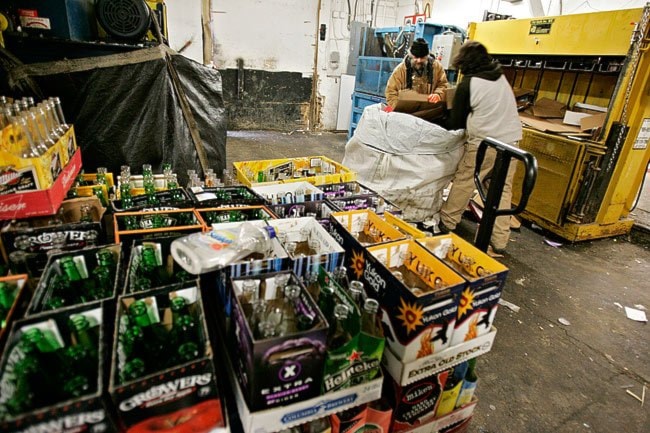Pat McInroy runs Whitehorse’s other recycling outfit.
You’ll be forgiven if you haven’t heard of it, or never visited P&M Recycling’s small warehouse, which is tucked away beside the old Coke plant on Ray Street, not far from the foot of Two Mile Hill.
Inside, the floor is tacky from pop and juice. The clang and clatter of bottles and cans fill the air. And the place smells of stale beer, thanks to stacks of empties sitting in a back room.
Three workers are busy sorting recyclables, which brings us to the first big difference between P&M and its better-known competitor, Raven Recycling. Customers here aren’t asked to separate their recyclables into a dozen different categories and stuff them into different bins.
Just pass your jumble of recyclables over the counter. “We take everything,” says McInroy, mentioning newspaper, boxboard, Tetra Paks, milk jugs, tin cans, glass bottles, plastic grocery bags: you name it.
P&M also has Raven beat in terms of location. While Raven is stuck out on Industrial Road, P&M is within walking distance of downtown.
Yet P&M, which opened its doors 11 years ago, remains a bit player in Whitehorse’s recycling trade. The company enjoys a small but loyal customer base, who usually queue up on weekends to trade their bottles and cans for coins.
But the company is largely overshadowed by Raven, a non-profit operation that is only kept alive with regular cash infusions from the territorial government.
McInroy emphasizes he has nothing against Raven. But he thinks it’s unfair that his competitor receives a generous operating grant, equal to monthly payments of $14,000, and he doesn’t.
“I’d love to be subsidized the same as Raven. That way we’d be on a level playing field.”
It’s been a tough past year for everyone in the recycling industry, and McInroy doesn’t expect to post a profit. But that’s bucking the trend for his company, which hires seven full-time staff, against Raven’s 18 full-time workers.
So how does a private operation like P&M, which may divert 350 tonnes of recyclables annually - about one-seventh of the volume handled by Raven - keep itself profitable without public dollars?
The simple way would be to turf unprofitable materials, such as plastic bags, into the landfill, but McInroy insists P&M recycles everything it can, and typically fills just one dumpster a week with stuff like soggy, contaminated paper that cannot be reused.
After all, if word got out that the recycling company was sending unprofitable goods to the landfill, the good will of his customer base would soon evaporate.
“This stuff is worthless,” said McInroy, gesturing to a bale of compressed plastic that weighs 450 kilograms. “But it’s part of the deal.”
Money flows in from several sources. One is the city, which pays $50 per tonne of waste that’s diverted from the landfill.
A bigger revenue stream is sorting and handling fees, in which McInroy collects part of the deposit paid on certain containers. For example, McInroy earns six cents on every Tetra Pak that’s taken, sorted, baled and shipped.
These handling fees generally offset the loss taken on shipping most recyclables south. Ever since the price of recyclables tanked in October of 2008, McInroy figures he’s taken a loss on shipping out everything, with one notable exception: crushed aluminum cans. They’re his cash cow.
About 800 cans are crushed into a brick the size of a small, carry-on suitcase that weighs 15 kilos.
The bricks are stacked on a wooden skid until it’s full, weighing 1,100 kilos, then wheeled with a hand-jack into the storage room.
He’s currently warehousing aluminum because the prices remain “pretty crappy.” But this is an exception. As a rule, McInroy is not a hoarder.
Some Canadian recycling operations have taken to stockpiling materials until prices recover. But McInroy figures the longer bales sit around, the more manpower is used shifting them about, and the higher the odds grow of goods becoming contaminated and consequently worthless.
Besides, space is at a premium. P&M is squeezed into a small warehouse once used by the Hougen Group to store archival material and cable equipment, and the whole building offers just 600 square metres of floorspace. Bales of junk plastic are stacked as high as the roof outside the building.
Over the past decade, McInroy has received about $50,000 in grants from the territory to upgrade equipment. This helped him to buy bailers last year that can crush goods four times as tightly as the machines they replaced, “so we’re not shipping air.”
Recyclables are trucked from Whitehorse to Skagway. From there, each load, weighing 17 tonnes, is barged to a buyer in Tacoma, Washington.
Not everything is shipped out. Brown bottles are returned to Yukon Breweries for reuse.
And green glass is now being fed into a crushing machine acquired this summer. Inside its blue metal frame is a paddle-wheel that spins at high speeds to pulverize bottles.
The machine spits out ground glass the consistency of fine gravel. It’s not sharp, so it’s safe to handle.
McInroy envisions this stuff one day being used as stucco, sandblast aggregate, or landscaping fill. Right now he’s using it to fill sandbags, on sale for seven dollars at Tags and Yukon Explosives.
But just as McInroy thought the optics were bad enough of him competing against a community-run recycling group, it turns out the Boy Scouts are selling sandbags, too. So he isn’t pushing them too hard this winter.
“I’m already known as the evil, private recycler,” he said with a chuckle. “I don’t need to go after the Boy Scouts, too.”
Contact John Thompson at
johnt@yukon-news.com.
